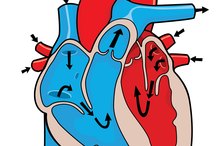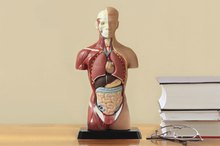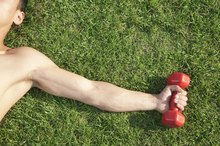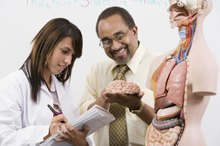Five Functions of the Muscular System
The human muscular system includes skeletal, smooth and cardiac muscle tissue. **Skeletal muscles attach to your bones, stabilizing the skeleton and enabling voluntary and reflexive movement.
If you are experiencing serious medical symptoms, seek emergency treatment immediately.
Smooth muscle tissue found in blood vessels and various body organs produces involuntary movement essential for normal function. ** Cardiac muscle occurs only in the wall of the heart, enabling its pumping action. In addition to structural and movement-related functions, the muscular system helps maintain normal body temperature 4.
Voluntary and Reflexive Movement
Skeletal muscles normally account for at least 40 percent of your body weight and are categorized as appendicular or axial based on body location.
The large muscles of your arms and legs are appendicular skeletal muscles.
The axial skeletal muscles include those of your trunk, head and neck. Contraction of skeletal muscle produces voluntary gross and fine movements, a primary function of the muscular system.
Gross movements rely primarily on large skeletal muscles. Fine motor skills refer to smaller, more intricate body movements. Examples include speaking, writing and playing a musical instrument.
Fine motor skills typically involve small skeletal muscles of your hands, face or feet. Although most skeletal muscles are under voluntary control, they can also contract reflexively -- such as blinking when an insect flies toward your face or pulling your hand away from a hot surface.
- Skeletal muscles normally account for at least 40 percent of your body weight and are categorized as appendicular or axial based on body location.
- The axial skeletal muscles include those of your trunk, head and neck.
Skeletal Stability and Organ Protection
What Is the Difference Between Smooth & Cardiac Muscle?
Learn More
Your bones provide the frame for your body.
Your skeleton, however, lacks structural stability without the skeletal muscles and their associated tendons that hold your bones together and keep them in place. Even in a static posture, such as when you're standing still, numerous skeletal muscles of the trunk, neck and legs must remain in a contracted state to support your body and head. The axial skeletal muscles are particularly important for maintaining an upright position, and enabling you to twist your head and body.
In conjunction with the rib and spinal bones of your trunk, the axial skeletal muscles also provide protection for your internal organs.
For example, your rectus abdominus, transverse abdominus and oblique muscles protect your abdominal organs from the front and side. Your latissimus dorsi, quadratus lumborum and psoas muscles protect the organs of your abdominal cavity from the back.
- Your bones provide the frame for your body.
- Even in a static posture, such as when you're standing still, numerous skeletal muscles of the trunk, neck and legs must remain in a contracted state to support your body and head.
Blood Circulation
Your heart is the hardest working muscle in your body, contracting at least 60 to 100 times per minute from cradle to grave.
The wall of your heart consists of highly specialized cardiac muscle tissue, which contracts involuntarily in response to electrical signals generated within the heart.
With each contraction of your heart, blood is pumped through your circulatory system. This essential function provides life-sustaining oxygen and nutrients to your body organs and tissues.
**Smooth muscle cells in the walls of your arteries and veins also contribute to blood circulation by altering the diameter of these blood vessels in different situations.
** For example, arteries supplying exercising skeletal muscles relax to enable increased blood flow to meet the increased metabolic demand. Conversely, if you're dehydrated or suffer a significant blood loss, the smooth muscle of your blood vessels contracts to help maintain your blood pressure and ensure continued circulation to your brain and other vital organs.
- Your heart is the hardest working muscle in your body, contracting at least 60 to 100 times per minute from cradle to grave.
- Smooth muscle cells in the walls of your arteries and veins also contribute to blood circulation by altering the diameter of these blood vessels in different situations.
Internal Organ Function
How Do the Walls of the Atria & Ventricles Differ?
Learn More
Several internal organs contain smooth muscle tissue, which contracts automatically to support their normal function. For example, smooth muscle tissue in the walls of your esophagus, stomach, and small and large intestines produce rhythmic contractions that propel food through your digestive tract. Similarly, smooth muscle in the wall of your bladder enables you to expel urine. Uterine smooth muscle tissue, called the myometrium, proliferates during pregnancy and provides the strong propulsive force that enables a vaginal delivery. Other internal organs and structures that rely on smooth muscle to support some of their functions include the gallbladder, male reproductive ducts and glands, and the irises of the eyes.
- Several internal organs contain smooth muscle tissue, which contracts automatically to support their normal function.
- Other internal organs and structures that rely on smooth muscle to support some of their functions include the gallbladder, male reproductive ducts and glands, and the irises of the eyes.
Body Temperature Regulation
A normal body temperature of roughly 98.6 F is generally lower than the environmental temperature.
Since body heat is lost to the environment in typical conditions, your body must generate heat to maintain a normal temperature. Most of this needed heat is generated by your skeletal muscles.
When your body temperature decreases, skeletal muscle activity automatically increases to generate heat. Shivering is the most obvious manifestation of this response.
Smooth muscle in the blood vessels supplying your skin also automatically constricts in cold conditions to conserve heat by limiting loss at your body surface. The opposite effect occurs when you're exercising or otherwise overheated. Smooth muscle cells in surface blood vessels relax, increasing blood flow and heat release through your skin.
Reviewed and revised by: Tina M. St. John, M.D.
- A normal body temperature of roughly 98.6 F is generally lower than the environmental temperature.
- Since body heat is lost to the environment in typical conditions, your body must generate heat to maintain a normal temperature.
Related Articles
References
- Journal of Applied Physiology: Local Control of Skeletal Muscle Blood Flow During Exercise: Influence of Available Oxygen
- Cardiovascular Physiology Concepts: Autonomic Innervation of the Heart and Vasculature
- Medical Physiology: Principles for Clinical Medicine, 4th Edition; Rodney A. Rhoades, Ph.D. and David R. Bell, Ph.D.
- Structure and Function of the Body, 15th Edition; Kevin T. Patton, Ph.D. and Gary A. Thibodeau, Ph.D.
Writer Bio
Paula Quinene is an Expert/Talent, Writer and Content Evaluator for Demand Media, with more than 1,500 articles published primarily in health, fitness and nutrition. She has been an avid weight trainer and runner since 1988. She has worked in the fitness industry since 1990. She graduated with a Bachelor's in exercise science from the University of Oregon and continues to train clients as an ACSM-Certified Health Fitness Specialist.







